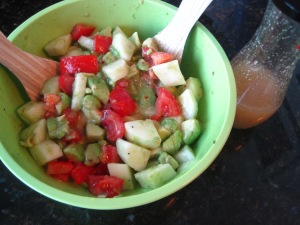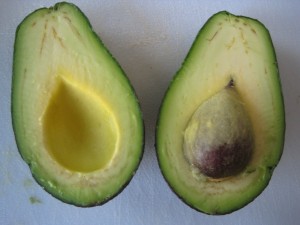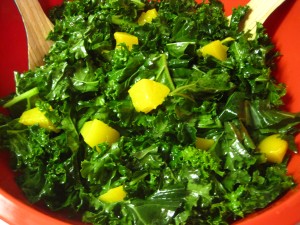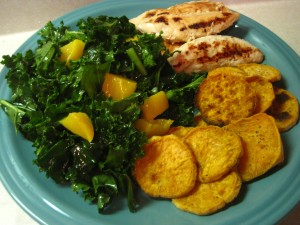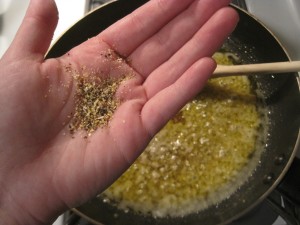This is definitely going to be more of my more “how-to,” “knowledge-packed” posts, so brace yourselves. But I promise it takes longer to say the title of this blog post than it does to make the salad and the dressing.
Clinton and I love salads. They’re so light and crisp and refreshing that for us, healthy is just a nice benefit. And I love having a nice, bright salad as a side dish to a simple chicken dinner, especially with summer right around the corner. Salads are such a simple addition to a potluck, BBQ by the pool, or picnic in the park. So the goal of this post is to take you step-by-step through what I like to buy for my perfect side salad, how I pick out my veggies, how to chop them, and how to make a super easy, homemade dressing.

While it looks like there are a lot of steps to this salad, it's really quite quick and simple. Not to mention, all that chopping is quite the stress-reliever!
What you’ll need:
For the salad (and how to pick it your veggies at the market):
- Head of iceberg lettuce
- Choose a head of lettuce that’s less rust-colored on the bottom. Also, choose one that’s the most tightly bound – that’s how you know it’s the freshest.
- 2 bell peppers – I usually do 1 red and 1 orange for color
- Choose the bell peppers with skins that look the waxiest.
- 4 carrots
- Carrots are carrots. Just choose ones that look good without blemishes.
- 6 or so stalks of celery
- Like the lettuce, choose celery that’s the most tightly bound and without blemishes.
- 1 medium jicama
- What’s jicama, you ask? It’s one of my favorite additions to salad ever. It’s just like watercress, but a little bit sweet. They kind of look like a really round, hairy potato or a less-hairy coconut. To pick out a good one, just find out with the most uniform skin without blemishes or bruises.
- 2-4 Roma tomatoes
- Choose tomatoes that are a rich red color and without blemishes. I find that a lighter red color means they’re less flavorful.
- 1-2 cucumbers
- Choose cucumbers that are dark green and firm when you squeeze them.
- 4 or so green onions
- Choose green onions that stand straight and don’t look wilted.

All my perfect veggies, ready to go. That round, beige-looking thing next to the lettuce? That's jicama. You'll usually find it near the Asian veggies.
For the salad dressing:
What you’ll need to do:
For a salad, I always start by making the salad dressing because it gives the flavors some time to marry. In whatever container is good for salad dressing, start by combining your zesty Italian salad dressing mix, lemon juice, and sherry. Shake or stir, and then set it aside until you’re done chopping all your veggies.
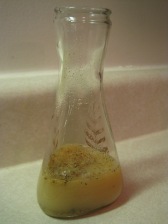
I have a pretty nifty salad dressing container that Clinton's mom gave me. If you have a container with a lid (like mine), just shake to mix. I leave the mix, lemon, and sherry in there for awhile so that the flavors can marry while I chop my veggies.
Next, have your veggies all out and ready to go with a good knife, cutting board, salad bowl standing by so you can throw your veggies in as you chop them, and your trash can sitting next to you. That’s right, have your trash can right next to you when you do this. In fact, I always have my trash can right at my feet whenever I cook so that I can toss tidbits right in as I go so I don’t have a big pile of garbage on my kitchen counter and in my way.
First, make sure you wash all your veggies that aren’t going to be peeled. Now on to chopping. I try to get rid of some of the bigger veggies first so that I can have more space on my counter as I chop. This is purely by choice, there’s no real order you need to chop the veggies.
Let’s start with the lettuce. Some people say it’s taboo to cut your lettuce with a knife or it’ll get that rust-colored look where you cut it. I find that it takes way too long to tear a head of lettuce by hand, and I almost never find that it gets rust-colored around the edges when I cut it with a knife. So I start by cutting the head of lettuce in half, and then cutting out the core by cutting diagonally into the head (throw the core right into the trash can next to you). Cut the rest of the lettuce in rough chops so you have big pieces.
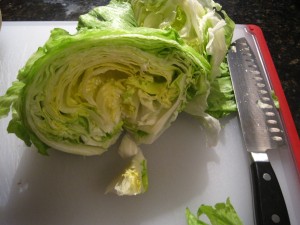
You can see how I take out just the core of the head of lettuce by cutting diagonally into it. This saves as much of the lettuce as possible for my salad.
For your bell peppers, cut them in half and then use your hands to tear out the big bunch of seeds and stem towards the top of the pepper. Then, because I often find it’s easier, cut the bell pepper into quarters so that you can use your knife to cut out the ribs. Make sure you get rid of all the seeds and ribs of the bell pepper – they don’t taste so great. Then slice into big chunks.
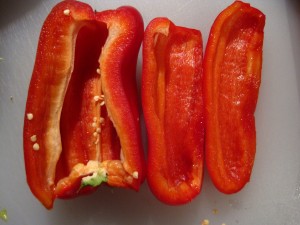
It's easier to cut this by putting the outside part down on the cutting board (as shown) and slicing your bell peppers this way. One the half you see quartered, you can see I sliced out the ribs and seeds. Even though I used my hands to tear out the big bulk of seeds from the other half, you can still see the ribs I need to cut out.
Your tomatoes will be chopped similarly to your lettuce, actually. Cut them in half, and then use your knife to diagonally cut out the very top of the tomato – this preserves the most amount of yummy tomato meat possible. Then, chop into big pieces. I typically like to take out the seeds of the tomato because they make the salad runny (but instead of throwing them in the trash can, I pop them into my mouth as a treat!).

Like the lettuce, you can see how I cut diagonally into the tomato to save as much of the meat as possible.
Celery is super easy. Chop off the ends of the celery, and then chop into nice big chunks. I love the crunch of celery in a salad!
Your green onions are the last veggie you can chop without peeling. Make sure to cut off the ends, and then chop into smaller pieces since onions are a lot stronger tasting than many of your other veggies.
Peeling veggies isn’t my favorite, but for this salad it’s totally worth it. I start with my cucumbers because they’re super easy and because I don’t have to wash my peeler before I move onto my other veggies (jicama, on the other hand, can get messy). Completely peel your cucumbers, then cut in half lengthwise so you have a nice flat surface to work with. Then, flat-side down, cut off the ends of the cucumbers, and then slice in medium slices.
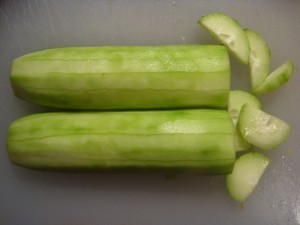
I put them flat-side down on my cutting board and then slice right through the rest of the cucumber. I like leaving the cucumbers in these bigger slices so you can really taste big bursts of them in your salad.
Now onto your carrots. Completely peel these, and then cut off the end that used to have the stem. Depending on how big your carrots are width-wise, you may want to cut them in half lengthwise like your cucumbers. But if they’re smaller, go ahead and chop in medium slices.
Lastly, onto the jicama. Now as good as jicama tastes, it’s quite the pain in the butt to peel – but so worth it. I start by cutting my jicama in half before I peel. This allows me to have a nice edge to work my peeler from because it’s definitely hard to get started. Make sure you get off all the jicama skin because it’s very hairy and not very good tasting. After it’s completely peeled, I chop it very similarly to how I chop an onion. Start by putting it flat-side down on your cutting board, and then slicing across the jicama vertically. Stack your jicama so that you can slice it again horizontally, making medium-sized chunks of jicama.

Here you can see it totally peeled and flat-side down on my cutting board. I slice all the way through the jicama (starting as shown), and then stack my slices and cut horizontally to make medium-sized chunks. Snack on a few of these pieces as you chop - it's so yummy!
By now, all your chopped veggies should be in your bowl and ready to go. Remember that salad dressing we made and set aside? Add the oil and then shake or stir. Toss with the salad, mixing up the dressing and the veggies. And you’re done!

While I normally throw my veggies in my salad bowl as I chop them, I laid them all out here so you can see what the finished product looks like. I generally like to chop my veggies in larger chunks so you get big bursts of flavor when you take a forkful.
It seems like a lot of work, but I promise it’s not. Once you get going with the chopping, it takes about as long to make this salad as it does to make a standard chicken dish (I recently made this with my Chinese BBQ chicken). And because it’s easier to make a salad like this in a large batch, you’ll have yummy, healthy, fresh leftovers all week that are a great compliment to any other dinner or are an easy lunch to bring to work. This salad is definitely a favorite in my house!






